Source: Glassnode; Compiled by: Wuzhu, Golden Finance
Summary
Bitcoin surged to $94,700 on optimism that U.S.-China tariff tensions could ease. Prices briefly recovered short-term holders’ cost basis, a key midpoint that distinguishes bear and bull phases.
The percentage of supply in profit climbed to 87.3% from 82.7% when BTC last traded at similar price levels. This suggests that nearly 5% of the supply changed hands in the recent correction.
The STH profit-loss ratio reached 1.0, indicating that many recent buyers are at breakeven, a level typically associated with exit risk. Realized profits also grew significantly, driven primarily by short-term investors locking in gains.
Futures open interest increased by 15.6%. However, while the market traded higher, funding rates turned negative, indicating rising short interest.
On April 22, U.S. spot Bitcoin ETFs saw a record high net inflow of $1.54 billion, indicating a massive influx of institutional demand. Normalized flow data shows that BTC demand far outstripped ETH demand through ETFs, which helps explain Ethereum’s relative underperformance.
After weeks of subdued activity and lower liquidity conditions, the market is finally responding positively to broader macro catalysts. Both equity and crypto markets rallied after the U.S. government sent optimistic signals about tariff relief on Chinese imports.
In the case of Bitcoin, the rally briefly broke through a key on-chain threshold: the short-term holder (STH) cost basis. The model reflects the average purchase price of market participants who have recently purchased tokens and often acts as a key pivot level. Historically, a sustained breakout above this price model marks a transition between bearish correction periods and renewed bullish sentiment during recoveries.
However, much like what happened between July and September 2024, this move has so far resulted in only a temporary recovery in STH's cost basis. This suggests nascent optimism, but does not yet confirm that the market has fully turned bullish. Sustained strength above this level could bolster market confidence as more investors return to meaningful unrealized investments.

The market's recent rally to $94,300 has coincided with a notable recovery in unrealized profits held by investors. The Profit Supply Percentage indicator has risen to 87.3%, a sharp rebound from the March lows.
When Bitcoin last traded at around $94,000, only 82.7% of supply was profitable. This means that since early March, as the market has moved sideways and lower, nearly 5% of the circulating supply has changed hands at lower prices.
Historically, typical excitement phases tend to be followed by this metric stabilizing above 90% for an extended period of time, indicating widespread profitability and increased investor confidence.
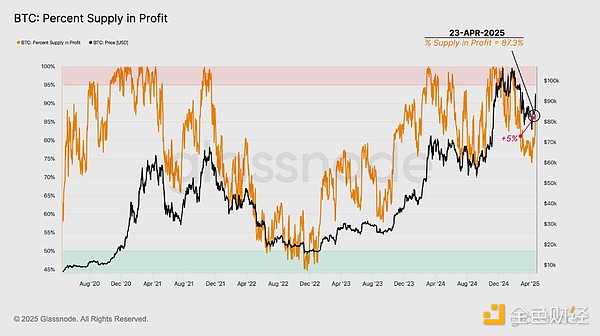
Another indicator that Bitcoin has returned to an important decision-making area is the STH supply profit-loss ratio, which has recently surged to a neutral level around 1.0. This shows that short-term supply is more evenly distributed between coins in terms of profit and loss, which makes the sentiment of this group more balanced.
This structure is very important. In previous bear markets, the STH-P/L ratio traded well below 1, and this level acted as a resistance ceiling. Whenever the indicator retests 1.0 from below, it tends to correlate with the formation of a local top as investors begin to exit positions and dampen momentum.
If the market can convincingly reclaim this level and trade above 1.0, it would be a signal of a stronger recovery. Monitoring how the ratio trades over the coming weeks, especially in conjunction with realized profit-taking behavior, could help gauge if the market is re-establishing a more constructive recovery from this correction.
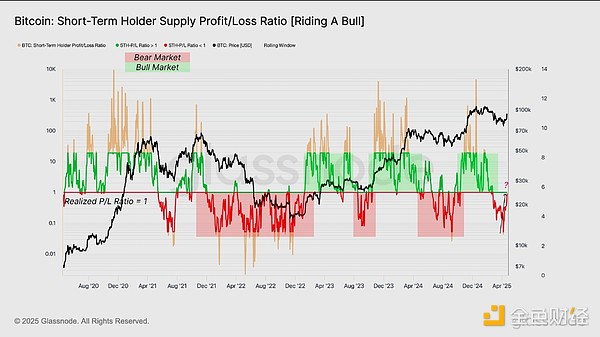
Profit-taking Stress Test
Now that we have the framework of a market at a decision point, profit-taking behavior becomes a key signal to monitor. Total realized profits for hourly solutions have now surged to $139.9 million/hour, about 17% above its benchmark of $120 million/hour.
This uptick suggests that many market participants are using this rally to lock in gains. If the market can absorb this selling pressure without collapsing, the road ahead will be brighter.
Conversely, a failure to hold these levels amid huge profit realizations could mark this move as another dead cat bounce, in line with previous relief rallies that faded under similar conditions.
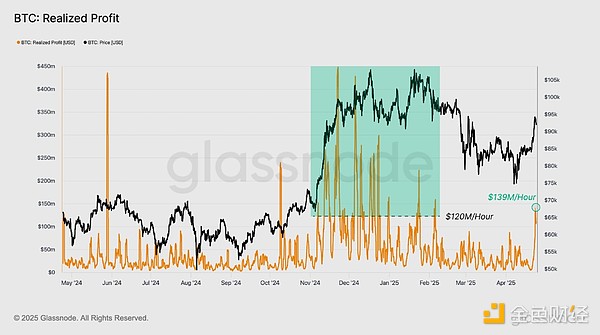
Who’s Taking Profits?
Beyond the amount of realized gains, understanding which groups are realizing profits can provide deeper insights into market sentiment. To this end, we employ the Spent Output Profit Ratio (SOPR) - a metric that compares the sale price of a token to its original cost basis, providing perspective on the average multiple of profit or loss locked in by investors.
The SOPR of Short-Term Holders (STH-SOPR) shows that recent buyers were the primary group locking in profits during the recent surge.
This is the first time since late February that STH-SOPR has significantly breached the breakeven level of 1.0, another relatively positive sign for investors to get back into profit positions. Overall, STH-SOPR trading above 1.0 for a sustained period is characteristic of a bullish uptrend.
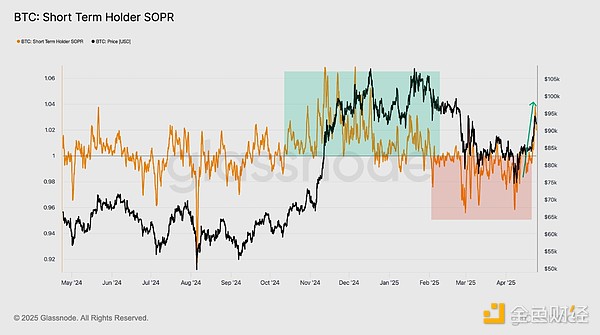
Short Perpetual Options
While some spot holders appear to be locking in profits, perpetual swap traders tend to go short on rallies. Open interest in perpetual swap contracts has climbed sharply to 281k BTC, up about 15.6% since the low of 243k BTC set in early March.
This reflects rising leverage in derivatives markets, which tends to exacerbate market volatility if prices start to hit traders' stop-loss or liquidation areas.
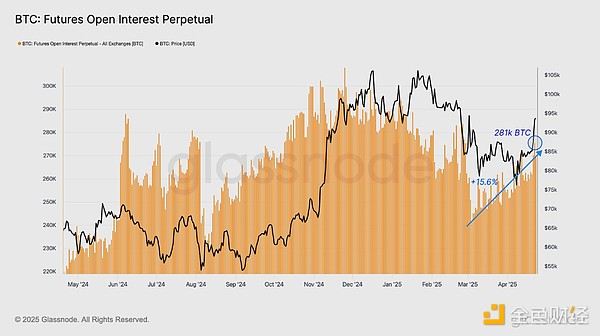
Interestingly, the surge in open interest coincides with a drop in the average funding rate, which plummeted to -0.023%. This suggests a growing bias toward short positions, suggesting that many traders are betting on a rebound and may believe that the recent move is overdone.
This divergence between rising open interest and negative inflows sets the stage for a possible short squeeze scenario if the upward momentum continues.
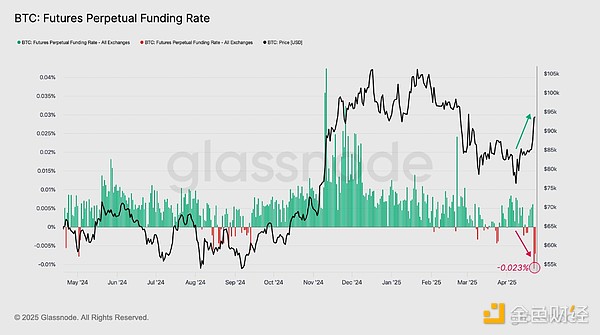
However, when zooming out to assess the long-term sentiment of perpetual swap traders, the picture becomes more cautious. The 7-day moving average of long funding paid per hour has steadily declined and is currently at $88,000 per hour and is still trending downward.
As an indicator of willingness to maintain long exposure, this indicator reflects the dollar value paid by traders on the "consensus" side of the market. The current downward trend in the premium suggests that most positions are indeed shifting to the short side, which creates an incentive for market makers to take long positions to collect funding rate interest.
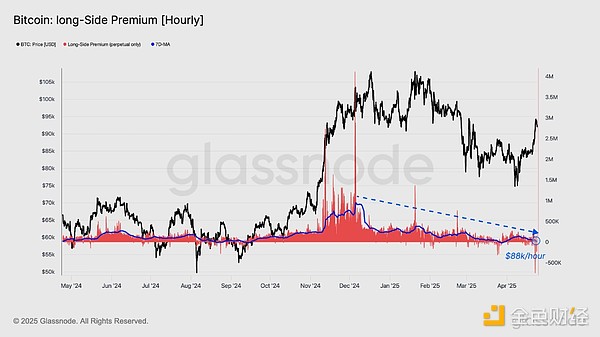
Institutional Interest
ETF flows have become an important indicator of institutional investor sentiment and demand in this cycle. Tracking inflows and outflows of ETF products provides a unique perspective on the conviction and participation of large capital allocators.
During Bitcoin's recent rally to $94,000, U.S. spot Bitcoin ETFs saw a staggering $1.54 billion in daily net inflows, one of the highest daily net inflows since its inception. This influx sends a strong signal that demand for Bitcoin may be starting to recover.
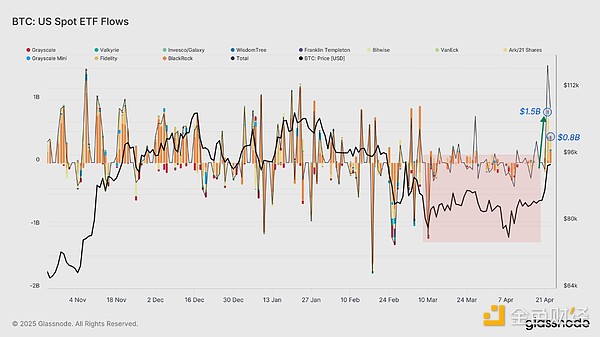
Is It Still Bitcoin Season?
Despite the strong rebound in Bitcoin prices, many are questioning why Ethereum has not seen the same magnitude of rebound. One answer lies in a comparison of ETF flows, which we normalize and adjust for each asset’s relative spot volume.
Over the past two weeks, Bitcoin ETFs have seen two clear waves of inflows, each exceeding 10% of BTC spot volume, highlighting relatively strong institutional demand.
In contrast,Ethereum ETF inflows have remained fairly subdued, with inflows less than 1% of ETH spot volume. This stark difference highlights the disparity in institutional demand between the two assets, which may be one reason why ETH has continued to underperform BTC recently.
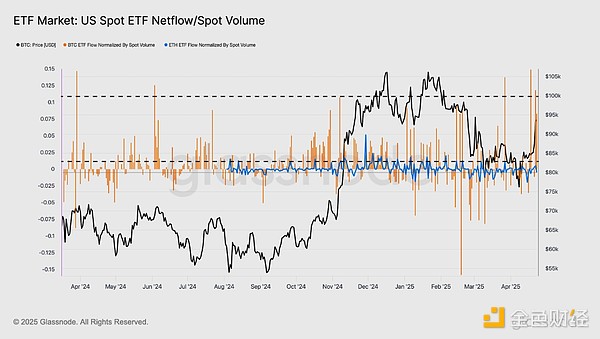
Conclusion
Bitcoin price rebounded above $94,000, reflecting macro optimism and a shift in investor sentiment. Positive signals around US-China tariffs sparked the rally, recovering short-term holders' cost basis and boosting the profit supply percentage to 87.3%. Multiple indicators suggest that Bitcoin is experiencing a positive recovery, while signs of a short squeeze are also emerging in the futures market.
Institutional demand for Bitcoin may be returning, with Bitcoin ETFs seeing $1.54 billion in net inflows in a single day. The market is at a decision point and the key level to watch is the cost basis of short-term holders, which can often outline bullish and bearish market structures. Bulls need to push the market to break through this price pattern and hold at that level.
 Miyuki
Miyuki














